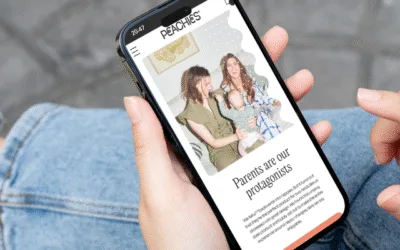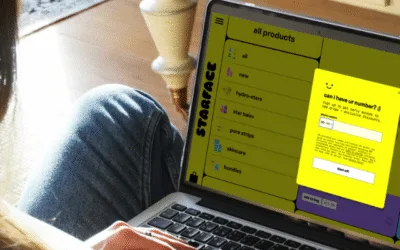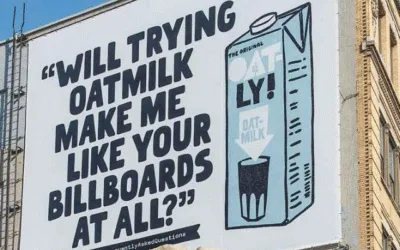Peachies beat Pampers by selling sleep, not nappies. Learn their Ladder of Why messaging trick to make your copy resonate.
This easy 5-min copy tweak can improve your conversions by 56.34%
Unbounce found a 24.3% drop in conversions when language gets too complex. Make your copy easy to read and make more sales.

Get pro copy tips, branding tricks and e-comm insights directly to your inbox every Tuesday.
💡This week’s big idea: Make your copy easy to understand for your customers even if they’re busy, burned out and distracted.
Unbounce recently published their annual report on conversion rates across all industries, including ecommerce.
And in that report (which is based on 57M conversions and 464M website visits across their users) they found something super interesting 👇
There’s now a negative 24.3% correlation between complex language and conversion rates.
That means that the more complex the language on your website, the more likely your customers are to bounce.
Not just that, but this has increased from -15% in 2020.
AKA a customer is now 62% more likely to bounce if they read complex words than they were just 5 years ago.
Now, this isn’t a “ugh, why can’t kids these days just read a book” kinda rant you’d find on your uncle’s Twitter feed.
Instead, it’s more a reflection of how we all process information in the post-Covid era where it feels like everybody always has a million mental plates spinning.
👆 Everyone’s brains, it seems.
In fact, based on a study from 2024, our average attention span is just 47 seconds. (Back in 2004, it was 2.5 minutes. That’s unreal.)
Put plainly, your customers are most likely tired, busy, and skimming your copy on their phone while they’re doing another task or half-watching the TV.
That doesn’t mean they don’t want to buy your stuff. And it doesn’t mean they’re too stupid to understand more complex stuff (which is how these stats often get spun).
It just means that they won’t buy it if it’s not written in a way that makes it easy for their busy brains to process.
But how do you do that? Let’s get into it 👇
As a copywriter, your #1 job is to get your copy read. Everything else comes after that.
There’s a common copywriting adage that says: the best copy is the copy that gets read.
Because, ultimately, you can have the slickest, fanciest, optim ized-up-the-wazoo copy in the world, but if people don’t read it, it’s not going to sell.
And there’s the thing.
It’s not necessarily true that easy words make us more likely to buy. It’s that hard words make us more likely to not buy.
There’s a subtle difference there.
It’s about removing friction to make your message easier to understand instantly, so your customer doesn’t have to stop for a second to actively think about what you’re saying.
It’s about making sure your customers stay in that sweet System 1 thinking spot, where we understand things quickly and make decisions easier.
And that means that the easier your words are to read, the less likely it is that your frazzled customers are going to close the tab and move on.
(Bonus benefit: as the incredibly titled study Consequences of Erudite Vernacular Utilized Irrespective of Necessity: Problems with Using Long Words Needlessly tells us: simpler language feels more trustworthy and true on a subconscious level, even before we consciously evaluate the actual content of what you’re saying. Which makes us more likely to buy.)
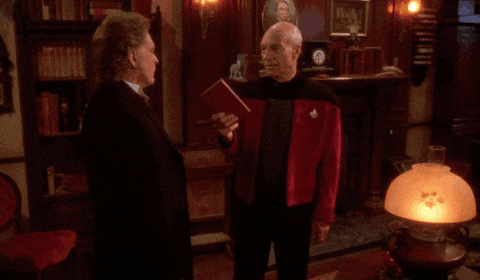
And the stats backs this up.
Here’s what the Unbounce study found 👇
Landing pages written at a 5th to 7th grade level convert at 11.1%, 56% higher than pages written at an 8th and 9th grade level (small change, big impact) and more than 2x higher than professional-level writing which converts at 5.3%.
And this isn’t just across one industry. It’s across the board, every industry, every niche. (Except for finance. We like people that watch our money to be a bit wordier, it seems.)
That’s unreal.
A landing page written at a 5th to 7th grade level is 56% more likely to convert than one that uses language that’s just a tiny, tiny bit more complicated.
(Note for us Brits: 5th grade means 9-10 years old. Grade 9 is 13-14 years old.)
🧠 Get the skinny on why reading age matters
By the time we are 5 or 6 years old, we’ll usually have 2,500 to 5,000 common words in our vocabulary.
As adults, we still find these words significantly easier to recognise and understand than any words we’ve learned since.In fact, by the age of 9, we’ve pretty much pinned down all the words that we’ll be able to understand immediately.
Everything else takes us a split, fraction of a second to understand.
And those minuscule pause pull us out of that flow state that means that we can understand what we’re reading, even if we’re stirring the dinner and watching the kids.
☝️ And that’s why measuring reading level is a super useful metric for checking your own copy.
At DWG, we use the Flesch-Kincaid scale to get a rough sense of how complex our writing is. It’s simple and efficient and it gives you a score out of 100. (Anything above 80 is really good.)
However, a quick warning: no reading age test is perfect, as they really only measures sentence length and syllables per word.
That means if we wrote one sentence with hippopotamus in and another that said fractured scapula, it would measure the hippo sentence as more complicated than the second.
So, take it with a pinch of salt and ask yourself:
👉 Would a 10-year-old understand this?
👉 Would I understand this if I was reading it in a hurry?
👉 Am I using words they’d actually say in conversation?
👉 Can I cut or simplify this sentence without losing meaning?
Small changes. Massive impact. Let’s see them in action 👇
Let’s pretend we’re working together on a copy brief for a client that makes a nootropic canned drink called Arete.
Their target audience is busy professionals, working parents and post-graduate students. Basically, anyone who is overworked and needing a bit of a brain boost.
They’ve spent years researching things like ashwaganda, L-theanine, adaptogens, etc… that are all proven to help reduce stress, improve concentration and keep you productive. They want their copy written in a voice that’s empathetic, empowering and wellness-adjacent.
Now, here’s what most copywriters would write for that 👇
(And full disclosure: we’ve been very guilty of this in the past, so no judgement here.)
Say no to burnout. Say yes to a better you.
Arete was born out of complete overload and burnout. We were stuck in never-ending days where your thoughts blur, your body’s wired, and nothing feels sustainable.
This nootropic drink was created to restore your clarity without the crash. It’s packed with clean caffeine, calming L-theanine and ashwagandha, and adaptogenic compounds that actually support cognitive function.
So whether you’re battling late nights, tight deadlines or the pressure to be always-on, every sip is a step back toward balance.
Objectively, this is really pretty good.
It solves a problem, tells the founder’s story, speaks to a very specific audience, show the what, the why and the how, paints a picture of a better future with the product…
And yet, because it’s written at a Grade 8/9 level, it’s statistically significantly less likely to convert.
But if we go through and do a final sweep to remove some complex words, tighten up the sentences and make it easier to read, we can make it 56.3% more likely to get somebody to click that “buy now” button 👇
Say no to burnout. Say yes to a better you.
Arete was born out of complete overload and burnout. Every day felt like we were stuck three steps behind.
That’s why we made a nootropic drink that helps you feel clear and focused, without the big crash after.
It’s packed with clean caffeine for more pep in your step. L-theanine and ashwagandha to protect your inner chill. And loads of herbs proven to help your brain deal with stress better.
So whether you’re battling late nights, tight deadlines or the pressure to be always-on, every sip is a step back towards a more balanced you.
Isn’t that crazy? The differences are so subtle that you probably wouldn’t even notice if you were skimming.
But our subconscious brains notice. And they’re the ones in the driving seat when we’re buying stuff.
How to make sure your copy is at a Grade 6 level
First of all, we 💛 the Hemingway App for checking reading age.
(And not just because Joe loves Hemingway so much his honeymoon was retracing Hemingway’s steps from A Moveable Feast in Paris.)
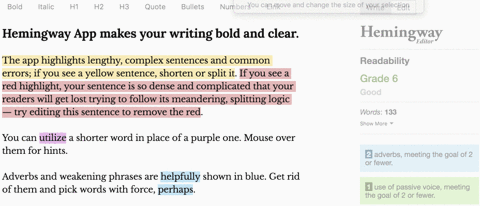
Just paste your copy in and it’ll tell you a) what reading level your writing is at and b) where you can fix it.
However, the one thing it doesn’t have is in-depth advice on how to lower your score. So here’s what we do:
👉 Break up long sentences.
Split complex thoughts into shorter, punchier lines. Forget about “proper grammar” and just focus on readability.
👉Use real words your customers would say.
Don’t say “premium sleep-enhancing formula.” Say “a drink that helps you wind down and stay asleep.” Easier to read and genuinely better copy, too.
👉 Ditch random capitalisation and Title Case
We don’t learn to read letter-by-letter, we learn to recognise words by their shapes. That means that Sentences Written Like This Are Much Harder To Read than sentences written like this. Stick to sentence case (even in headlines) and your writing will be so much easier to scan and take in.
👉 Read it out loud.
If it sounds clunky in your mouth, it’ll sound clunky in your reader’s brain.
👉 Use the active voice
The active/passive voice is one of those things that people either get or they don’t. TBH, it took us a few years to really get it.
Here’s the TLDR: the active voice helps the reader immediately identify the subject of the sentence and understand it much quicker. Active sentences have a subject, passive sentences don’t.
Like this 👇
Passive: This drink was created to help burnout.
Active: We created this drink to help burnout.
How to recognise the passive voice
It’s very easy to slip into the passive voice. An easy way to spot passive voice it is to add “by zombies” (or monkeys, or giraffes, or aliens or whatever takes your fancy) after the verb. If the sentence makes sense, you’re using the passive voice.
This drink was created by zombies to help burnout? That makes sense, so it’s written in the passive voice.
We created by zombies this drink to help burnout. That’s utter gobbledigook, which means we’re writing in the active voice. 🙌
🏆 Reading age inspo: 3 brands who have nailed the art of simple (but effective) copywriting
Bol, Finisterre and Planthood have all got reading ages of Grade 6 or below on their homepages. And yet, the copy is still super effective. It doesn’t feel patronising or simplistic or like it’s speaking down to us.
In fact, you get a sense of “oh nice, I get this brand. Maybe I’ll buy their stuff”.
☝️ And that is exactly why checking your reading age is so important. It makes it easier for customers to get that “aha!” moment when they read your copy.
Then, once they’ve got that, you can get lay the ground work to make the sale.
Want to check your reading age? 👉 Whack your website into this handy tool.(And if you need a hand tweaking your copy, you know where we are.)
Oh! This post is written at a Grade 6 level. Practice what you preach and all that 😉
Dive into more free tips and tricks 👇
How Starface use orthography to build a killer brand voice their customers love
The words you write matter. But so do your full stops, emojis and lowercase letters. Learn how to turn punctuation into a powerful part of your brand voice.
Why Oatly’s brand voice is so damn good (and how yours can be, too)
We dig into the three layers of brand voice (10,000ft, 1,000ft, ground level), show how Oatly nails each one and how you can do it for your own brand.
The weekly newsletter that takes your brand’s copy from “meh” to “hell f*cking yeah!”
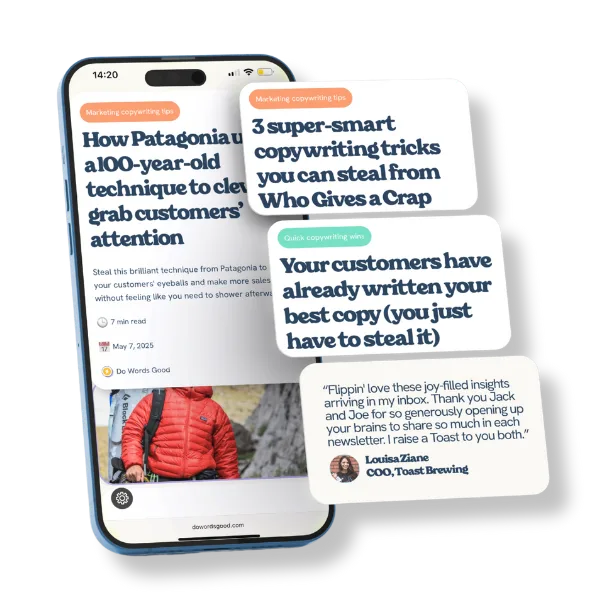
Read every week by legends at brands like these











